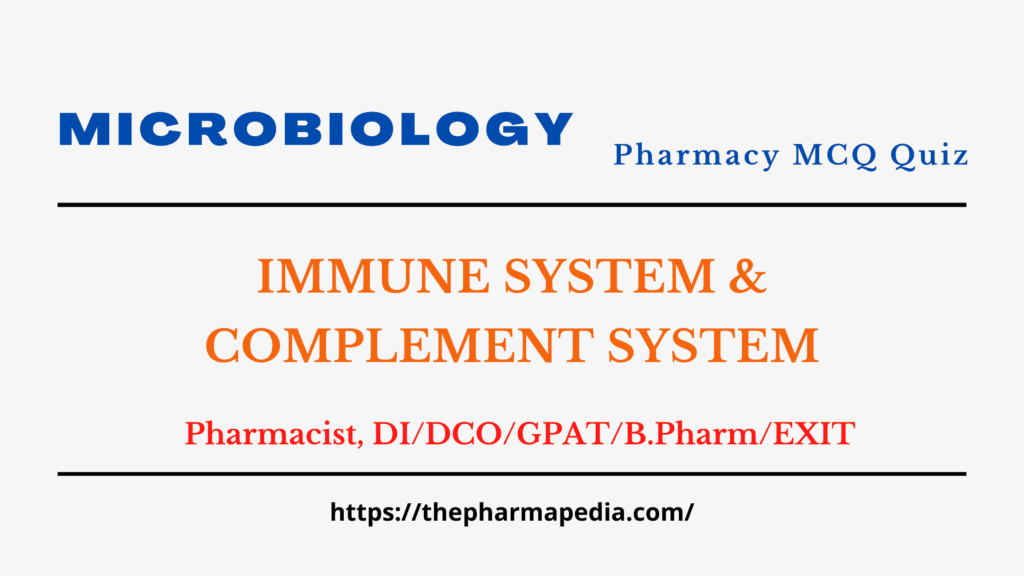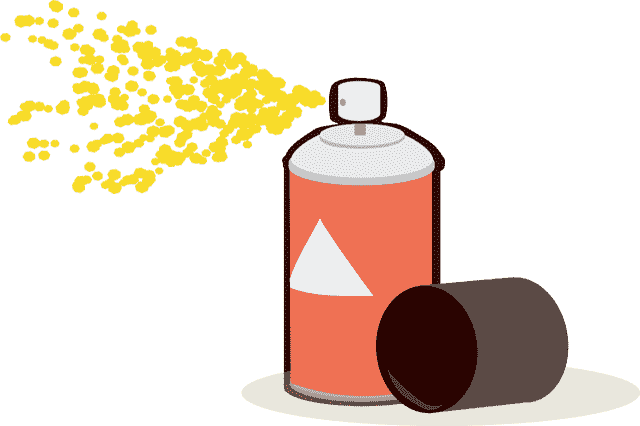COMPLEMENT SYSTEM
1. Classical pathway of the complement is activated by:
- a. Antigen
- b. Antibody
- c. Antigen – Antibody complex
- d. None of the above
View Answer
C
2. The alternative pathway of the complement is initiated by:
- a. Endotoxins
- b. Lipopolysaccharides
- c. Yeast cell walls
- d. All of the above
View Answer
D
3. What is the chemical nature of components of complement?
- a. Protein
- b. Lipopolysaccharide
- c. Lipid
- d. None of the above
View Answer
A
4. First component of complement which binds to antigen-antibody complex in classical pathway is:
- a. C1q
- b. C1r
- c. C1s
- d. C3
View Answer
A
5. Which complement of complement is present in the highest concentration in the serum?
- a. C1
- b. C2
- c. C3
- d. C5
View Answer
6. Factor B and Factor D are important components of:
- a. Classical pathway of complement
- b. Alternative pathway of complement
- c. Both of the above
- d. None of the above
View Answer
B
STRUCTURE AND FUNCTIONS OF IMMUNE SYSTEM
7. E-rosettes are formed by
- a. T cells
- b. B cells
- c. Macrophages
- d. Monocytes
View Answer
A
8. EAC rosettes are formed by:
- a. T cells
- b. B cells
- c. Macrophages
- d. None of the above
View Answer
B
9. CD3 receptor is present on:
- a. T cells
- b. B cells
- c. Macrophages
- d. Monocytes
View Answer
A
10. CD-4 antigen is present on:
- a. T-helper cells
- b. Macrophages
- c. Monocytes
- d. All of the above
View Answer
D
11. CD8 antigen is present on:
- a. T helper cells
- b. T suppressor cells
- c. Both of the above
- d. None of the above
View Answer
B
12. Natural killer cells play an important role in:
- a. Antiviral activity
- b. Antitumour activity
- c. Allograft rejection
- d. All of the above
View Answer
D
13. CD8 cells can recognise:
- a. MHC class I antigen
- b. MHC class II antigens
- c. MHC class III antigens
- d. All of the above
View Answer
A
14. Class II MHC antigens are present on:
- a. Macrophages
- b. Monocytes
- c. Activated T lymphocytes (CD4)
- d. All of the above
View Answer
D
15. Which of the following HLA types is associated with ankylosing spondylitis?
- a. HLA-B27
- b. HLA-DR4
- c. HLA-DP
- d. None of the above
View Answer
A
16. Which of the following HLA types is associated with rheumatoid arthritis?
- a. HLA-B27
- b. HLA-DR4
- c. HLA-A1
- d. None of the above
View Answer
B
IMMUNE RESPONSE
17. Cell mediated immunity (CMI) plays an important role in:
- a. Allograft rejection
- b. Type IV hypersensitivity reactions
- c. Graft-versus-host reaction
- d. All of the above
View Answer
D
18. B-lymphocytes which have a long lifespan and can recognize the same antigen on subsequent exposure are named:
- a. Memory cells
- b. Killer cells
- c. Natural killer cells
- d. None of the above
View Answer
A
19. The widely accepted theory of antibody formation is:
- a. Direct template theory
- b. Indirect template theory
- c. Natural selection theory
- d. Clonal selection theory
View Answer
D
20. The animal used for monoclonal antibodies production is:
- a. Mouse
- b. Guinea pig
- c. Rabbit
- d. None of the above
View Answer
A
21. The technique used for monoclonal antibodies production is:
- a. Hybridoma
- b. Rosette formation
- c. Opsonisation
- d. Immunoflorescence
View Answer
A
22. Interleukin-1 (IL-1) is principally secreted by:
- a. Macrophages
- b. Monocytes
- c. Both of the above
- d. None of the above
View Answer
C
23. Main functions of interleukin-1 (IL-1) are
- a. Stimulation of T cells for production of IL-2
- b. B cell proliferation
- c. Neutrophil chemotaxis
- d. All of the above
View Answer
D
24. Which of the following methods can be used to detect cell mediated immunity?
- a. Skin tests for delayed hypersensitivity
- b. Lymphocyte transformation test
- c. Migration inhibiting factor test
- d. All of the above
View Answer
D
25. Which of the following mechanisms can be used to induce immunological tolerance?
- a. Clonal energy
- b. Clonal deletion
- c. Suppression
- d. All of the above
View Answer
D
IMMUNODEFICIENCY DISEASES
26. DiGeorge’s syndrome is an immunodeficiency disease due to:
- a. T cell defects
- b. B cell defects
- c. Both of the above
- d. None of the above
View Answer
A
27. Which of the following defects occur in Nezelof’s syndrome.
- a. T cell defects
- b. B cell defects
- c. Both of the above
- d. None of the above
View Answer
C
28. Wiskott-Aldrich syndrome is an immunodeficiency disease which occurs due to :
- a. T cell defects
- b. B cell defects
- c. Both of the above
- d. None of the above
View Answer
C
29. Chediak-Higashi syndrome is an immunodeficiency disease which occurs due to:
- a. T cell defects
- b. B cell defects
- c. Complement disorder
- d. Diminished phagocytic activity
View Answer
D
30. Chronic graulomatous disease occurs due to deficiency of:
- a. NADPH Oxidase
- b. G6PD enzyme
- c. Both of the above
- d. None of the above
View Answer
A
Get More Quiz below…
Category: Microbiology
Join Our WhatsApp Group to receive the latest updates like Pharma Job notifications, study materials, admission alerts, Pharma News, etc
Join Our Telegram Group to receive the latest updates like Pharma Job notifications, study materials, admission alerts, Pharma News, etc
Join Our Telegram Group to Download Free Books & Notes, Previous papers for D.Pharm, B.Pharm, M.Pharm, Drug Inspector & GPAT……….



